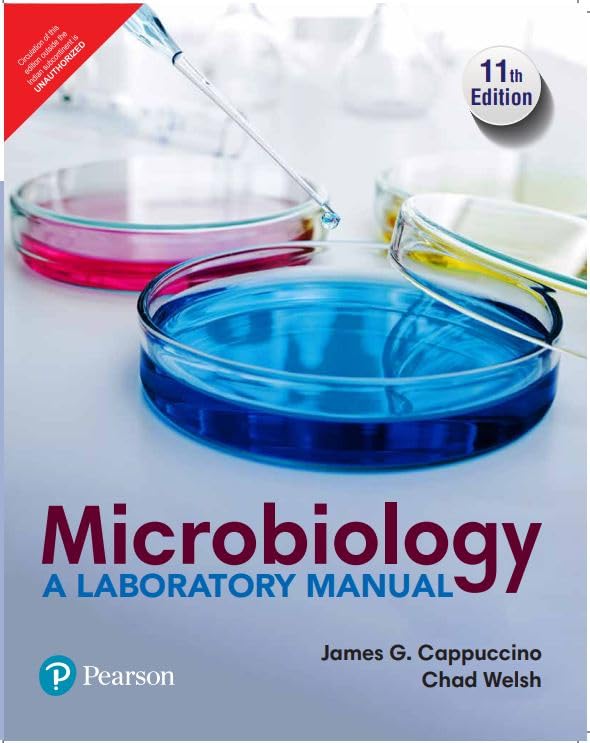Microbiology: A Laboratory Manual, 11/e
Easy to adapt for almost any microbiology lab course, this versatile, comprehensive, and clearly written manual can be paired with any undergraduate microbiology text. Known for its thorough coverage, straightforward procedures, and minimal equipment requirements, the Eleventh Edition incorporates current safety protocols from governing bodies such as the EPA, ASM, and AOAC. The new edition also includes alternate organisms for experiments for easy customization in Biosafety Level 1 and 2 labs. New lab exercises have been added on Food Safety and revised experiments, and include options for alternate media, making the experiments affordable and accessible to all lab programs. Ample introductory material, engaging clinical applications, and laboratory safety instructions are provided for each experiment along with easy-to-follow procedures and flexible lab reports with review and critical thinking questions.
Features:
- A new experiment on the Propagation of Isolated Bacteriophage Cultures has been added that guides students to isolate bacteriophages for genetic manipulation.
- Biosafety Levels (BSLs) have been added to the Eleventh Edition to alert students to appropriate safety techniques.
- Tips for Success appear in select experiments and draw attention to common mistakes and stumbling blocks in the lab.
- Revised experiments include options for alternate media, making the experiments affordable and accessible to all sizes of lab programs. Experiment 60 has been revised to focus on the normal microbiota of human skin and the importance of hand washing.
- Easy-to-adapt Lab Reports include blank spaces or options for “alternate organisms” for easy customization with organisms that are readily available
- Numerous photographs in full color and illustrations help students visualize techniques and expected results.
Contents:
- Part 1 – Basic Laboratory Techniques for Isolation, Cultivation, and Cultural Characterization of Microorganisms
- 1. Culture Transfer Techniques
- 2. Techniques for Isolation of Pure Cultures
- 3. Cultural Characteristics of Microorganisms
- 4. Microscopic Examination of Stained Cell Preparations
- 5. Microscopic Examination of Living Microorganisms Using a Hanging-Drop Preparation or a Wet Mount
- Part 2 – Bacterial Staining
- 6. Preparation of Bacterial Smears
- 7. Simple Staining
- 8. Negative Staining
- 9. Gram Stain
- 10. Acid-Fast Stain
- 11. Differential Staining for Visualization of Bacterial Cell Structures
- Part 3 – Cultivation of Microorganisms: Nutritional and Physical Requirements, and Enumeration of Microbial Populations
- 12. Nutritional Requirements: Media for the Routine Cultivation of Bacteria
- 13. Use of Differential, Selective, and Enriched Media
- 14. Physical Factors: Temperature
- 15. Physical Factors: pH of the Extracellular Environment
- 16. Physical Factors: Atmospheric Oxygen Requirements
- 17. Techniques for the Cultivation of Anaerobic Microorganisms
- 18. Serial Dilution—Agar Plate Procedure to Quantitate Viable Cells
- 19. The Bacterial Growth Curve
- Part 4 – Biochemical Activities of Microorganisms
- 20. Extracellular Enzymatic Activities of Microorganisms
- 21. Carbohydrate Fermentation
- 22. Triple Sugar—Iron Agar Test
- 23. IMViC Test
- 24. Hydrogen Sulfide Test
- 25. Urease Test
- 26. Litmus-Milk Reactions
- 27. Nitrate Reduction Test
- 28. Catalase Test
- 29. Oxidase Test
- 30. Utilization of Amino Acids
- 31. Genus Identification of Unknown Bacterial Cultures
- Part 5 – The Protozoa
- 32. Free-Living Protozoa
- 33. Parasitic Protozoa
- Part 6 – The Fungi
- 34. Cultivation and Morphology of Molds
- 35. Yeast Morphology, Cultural Characteristics, and Reproduction
- 36. Identification of Unknown Fungi
- Part 7 – The Viruses
- 37. Cultivation and Enumeration of Bacteriophages
- 38. Isolation of Coliphages from Raw Sewage
- 39. Propagation of Isolated Bacteriophage Cultures
- Part 8 – Physical and Chemical Agents for the Control of Microbial Growth
- 40. Physical Agents of Control: Moist Heat
- 41. Physical Agents of Control: Electromagnetic Radiations
- 42. Chemical Agents of Control: Chemotherapeutic Agents
- 43. Determination of Penicillin Activity in the Presence and Absence of Penicillinase
- 44. Chemical Agents of Control: Disinfectants and Antiseptics
- Part 9 – Microbiology of Food
- 45. Microbiological Analysis of Food Products: Bacterial Count
- 46. Microbial Fermentation
- Part 10 – Microbiology of Water
- 47. Standard Qualitative Analysis of Water
- 48. Quantitative Analysis of Water: Membrane Filter Method
- Part 11 – Microbiology of Soil
- 49. Microbial Populations in Soil: Enumeration
- 50. Isolation of Antibiotic-Producing Microorganisms and Determination of Antimicrobial Spectrum of Isolates
- 51. Isolation of Pseudomonas Species by Means of the Enrichment Culture Technique
| Book | |
|---|---|
| Author | Cappuccino / Welsh |
| Pages | 568 |
| Year | 2023 |
| ISBN | 9789353436568 |
| Publisher | Pearson |
| Language | English |
| Uncategorized | |
| Edition | 11/e |
| Weight | 835 g |
| Dimensions | 20.3 x 25.4 x 4.7 cm |
| Binding | Paperback |


